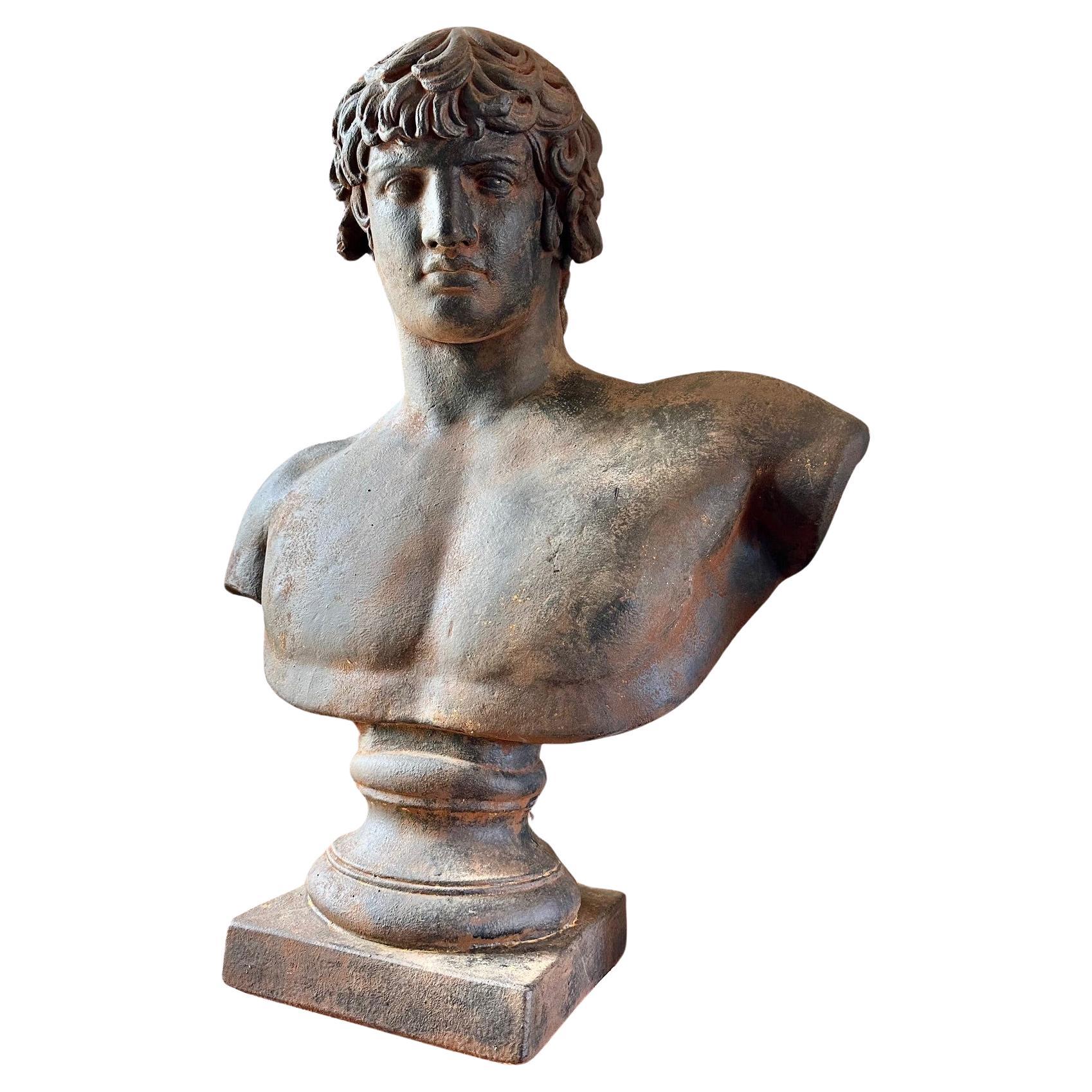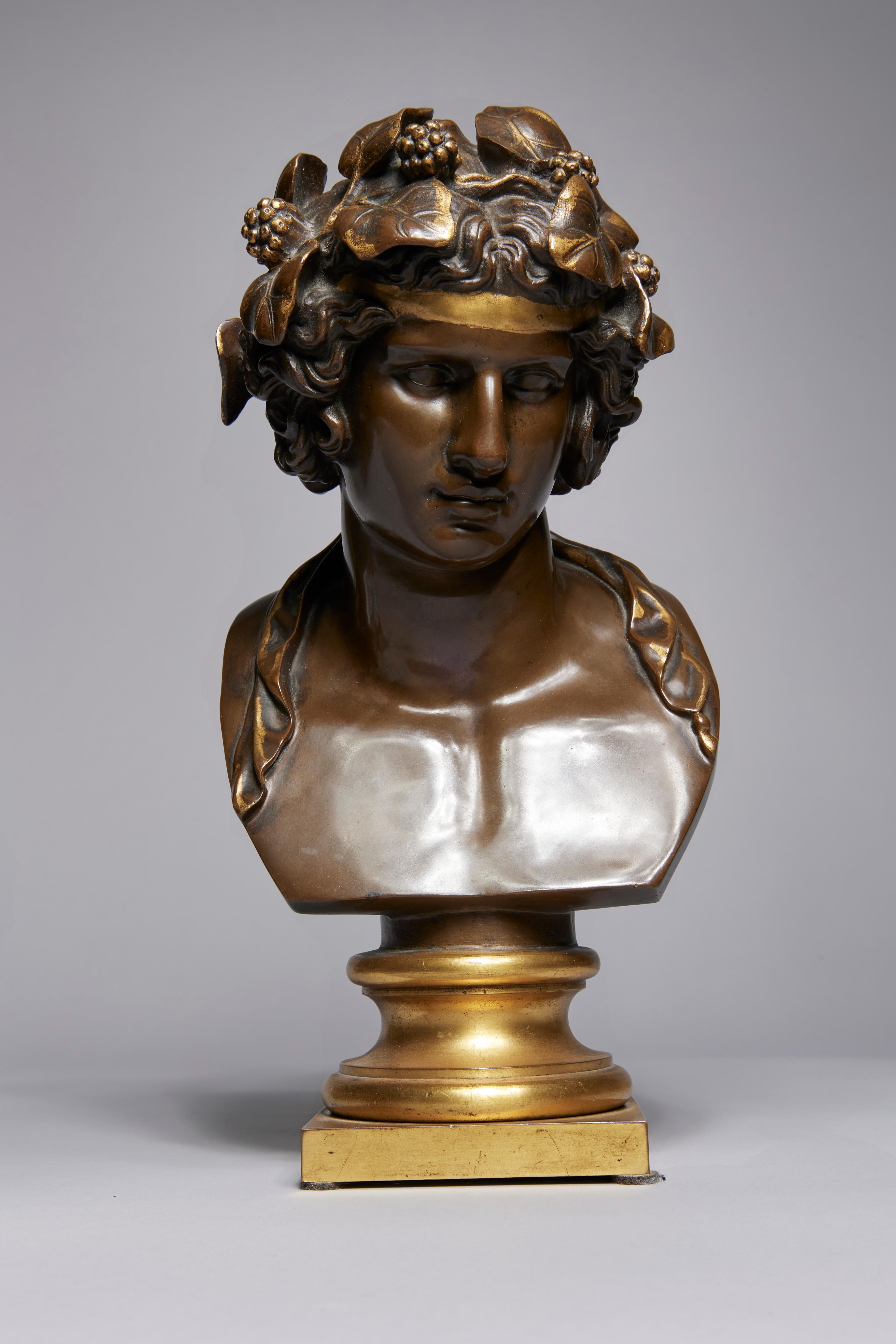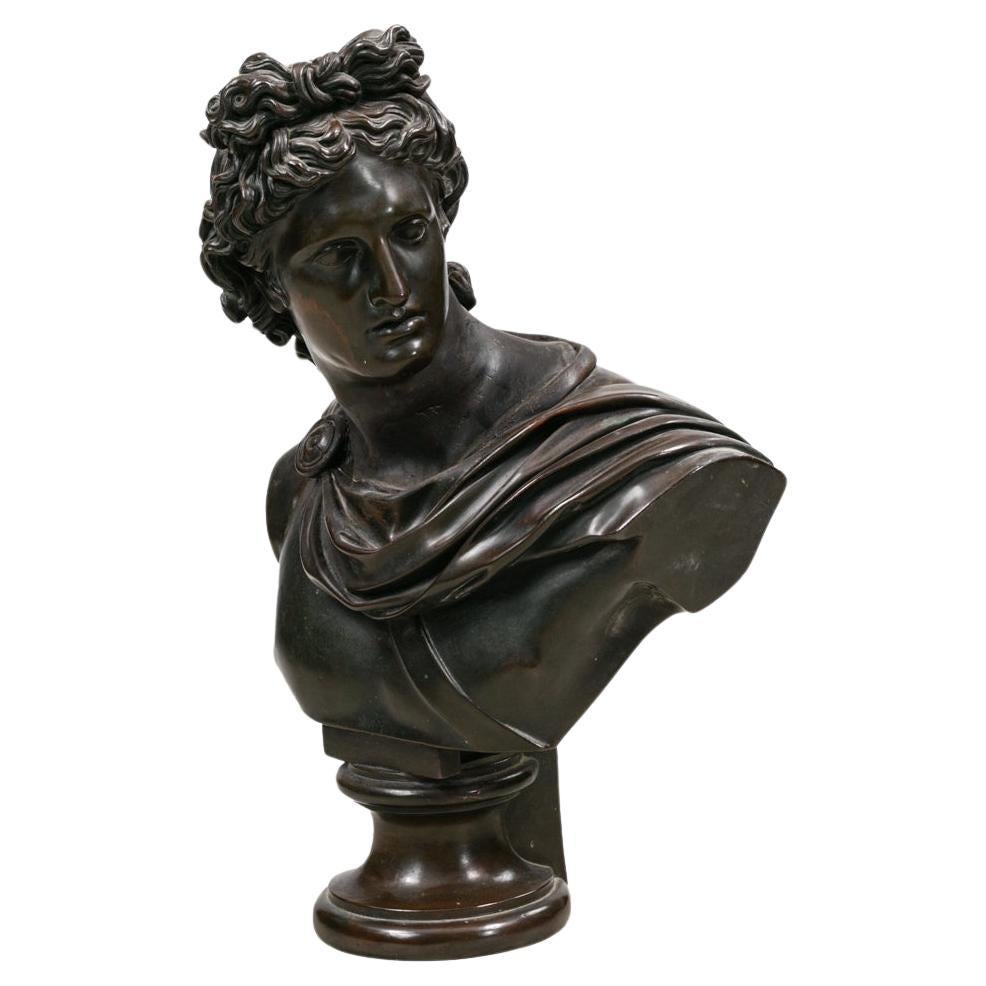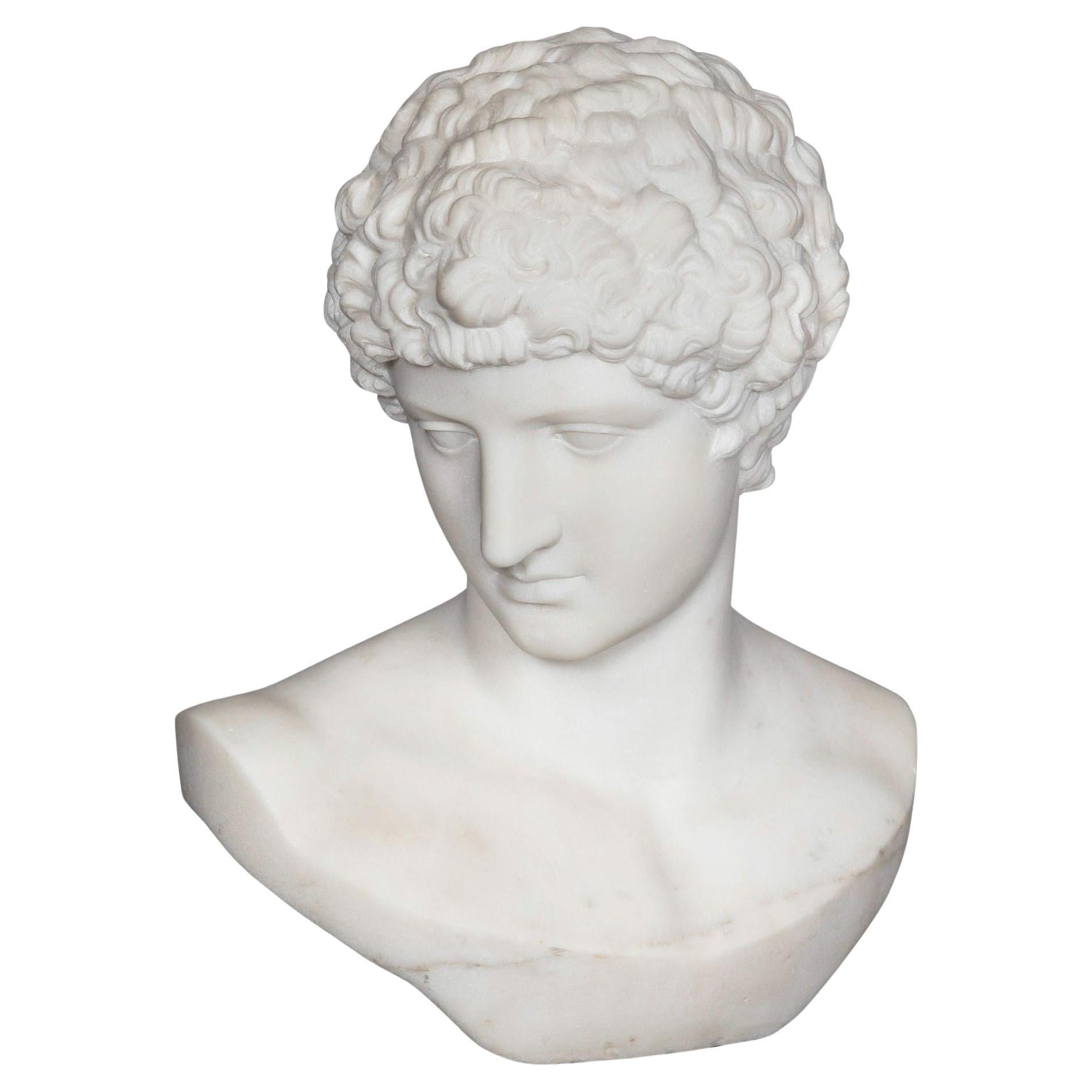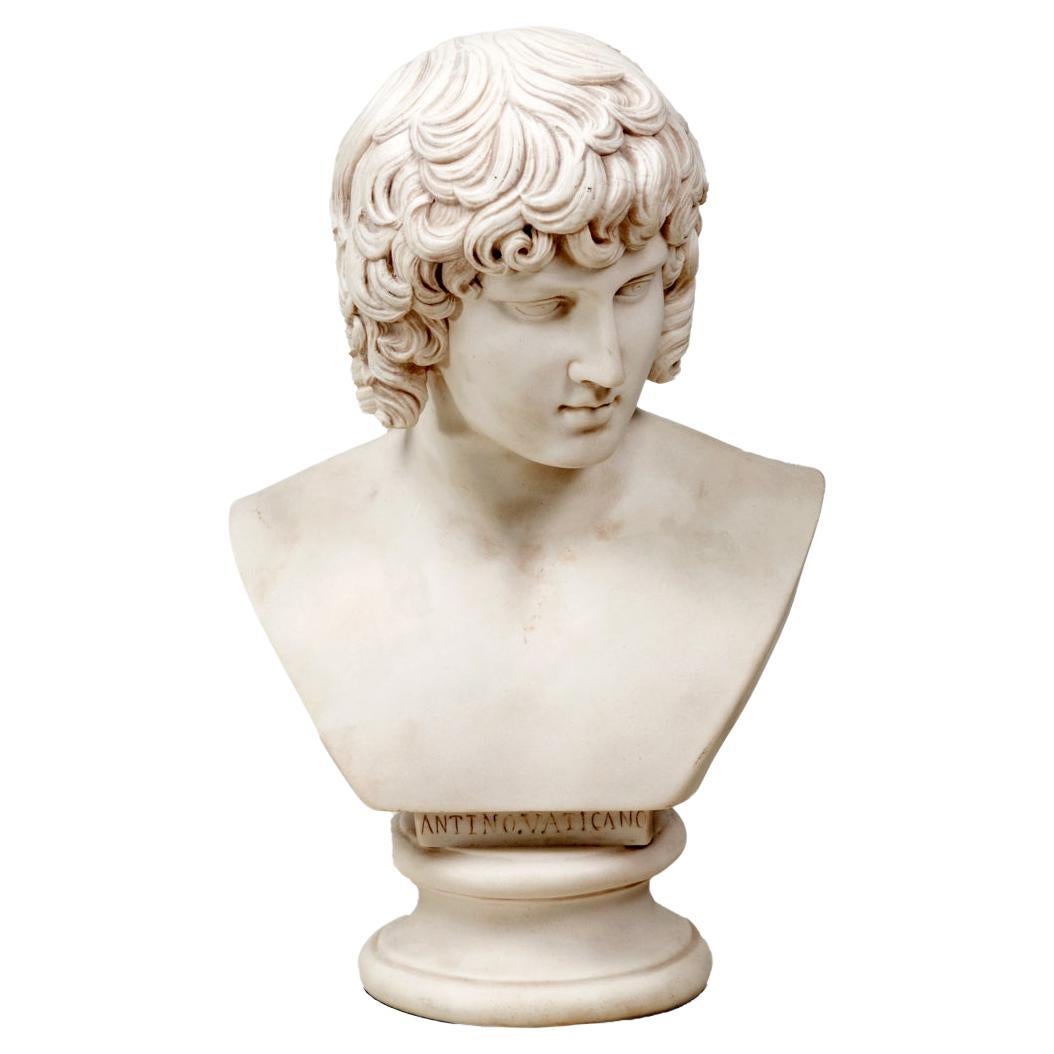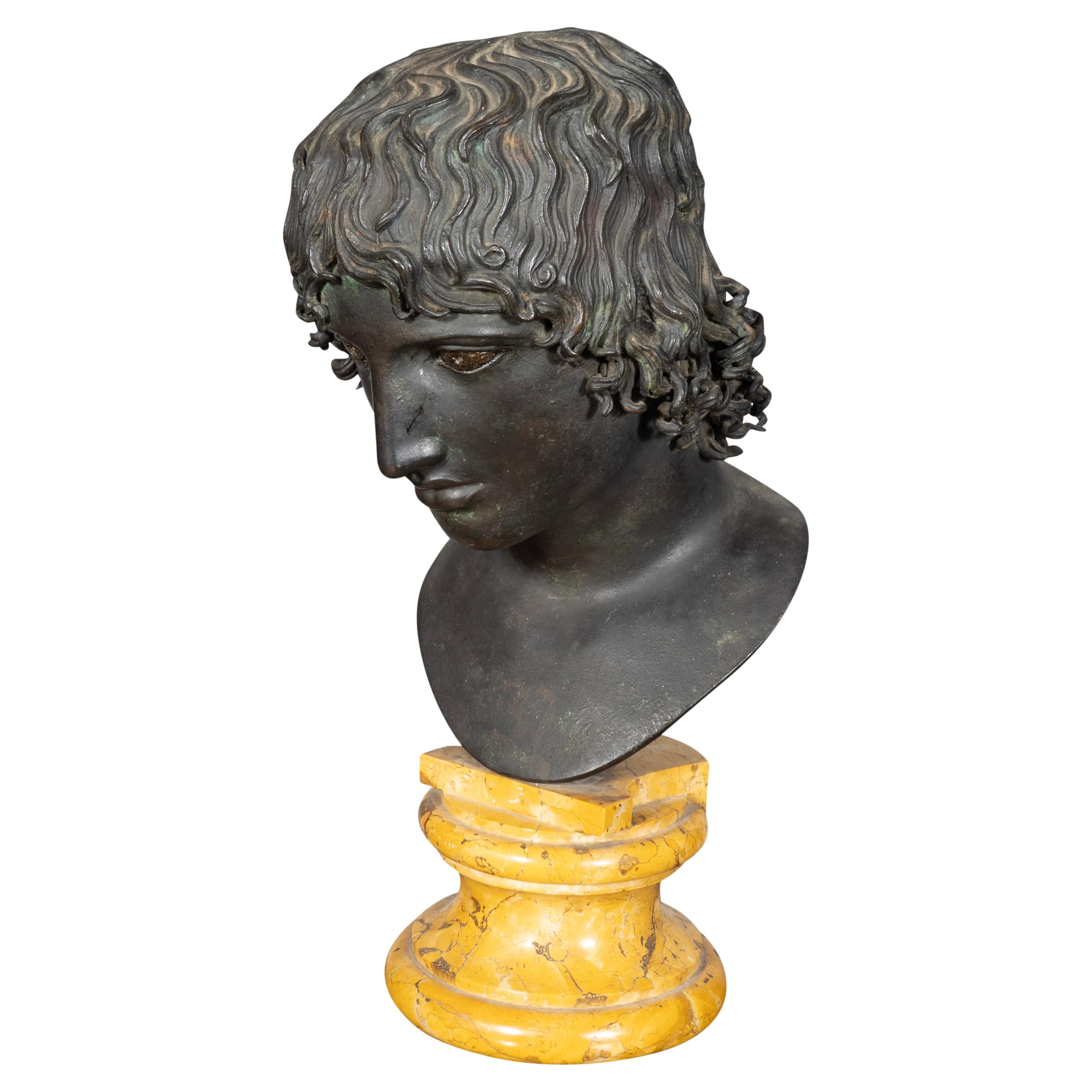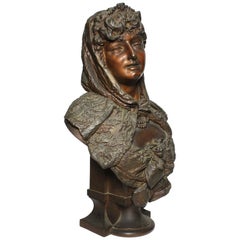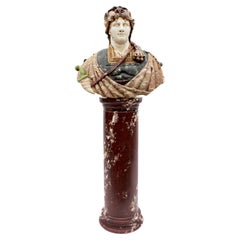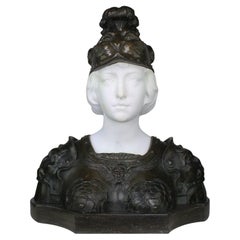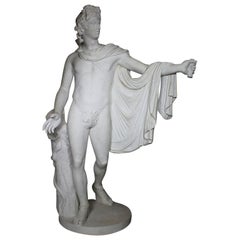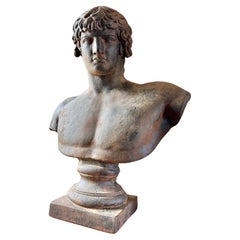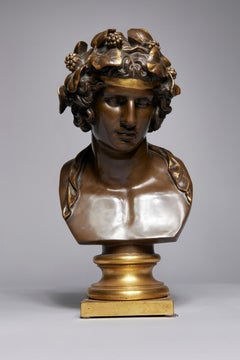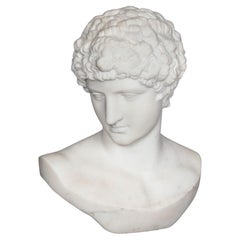Items Similar to Monumental French 19th Century Cast-Iron Bust of 'Head of Antinous as Dionysus'
Video Loading
Want more images or videos?
Request additional images or videos from the seller
1 of 22
Monumental French 19th Century Cast-Iron Bust of 'Head of Antinous as Dionysus'
$34,500
£26,335.91
€30,274.91
CA$48,547.67
A$53,987.02
CHF 28,355.15
MX$660,045.49
NOK 353,332.37
SEK 333,097
DKK 225,948.66
About the Item
A Monumental French 19th Century Patinated and Parcel Gilt Cast-Iron Bust of 'Head from a Statue of Antinous as Dionysus' Wearing a Wreath of Ivy - Roman Bacchus, God of the Wine, after the Greek models of the mid-4th century BC. Bust. This monumental larger-than life bust, cast by the Parisian foundry 'J.J. DUCEL Me de FORGES, PARIS', is an exceptional example of artistic skills in copying antique forms and modernizing them by using cast-iron. Antinous was a handsome youth, a Greek from Bythinia. The favorite of the Roman Emperor Hadrian (117-138). The Emperor Hadrian became obsessed with Antinous, a young man from Asia Minor, to the extent that the Emperor created a cult of Antinous when the young man died, in 130 CE. He was tragically drowned in the Nile during a drip to Egypt with the Emperor in 130 CE. According to one version, he died saving the Emperor's life. After the death of Antinous, Hadrian ordered that he be deified. His statues, as the gods Dionysius or Hermes, adorned Hadrian's villa at Tivoli just outside Rome. The original portrait, currently at The State Hermitage Museum, St.Petersburg, was found during excavations at Tivoli in 1769. Antinous is shown as Dionysius, god of wine and merrymaking, his luxuriant locks of hair crowned with a branch of Italian pine. The young man's face is classically handsome and his idealized features recall a Greek statue of the Classical period. At the same time there are still traces of individual features, such as the thick brows over the small, close-set eyes. The expression of sadness is typical of many statues of Antinous, who died so young. In European art, the image of Antinous became synonymous with ideal male beauty. Cast-Signed "J.J. DUCEL Me de FORGES, PARIS". Circa: Paris, 1880-1890.
A retailer of fine cast-iron ornaments, J. J. Ducel was recorded as supplying cast-iron works through Paris as early as 1810 in the Pas-de-Calais. The factory was sold in 1878 to the Fonderie de la Haute-Marne and all of the firm's models were subsequently bought by the Val d'Osne foundry. However, prior to the firm's sale, critics at the 1867 Paris Exposition Universelle proclaimed that "Ducel is the great manufacturer of works in cast-iron, to whom Paris is so largely indebted for the grace and elegance that supply so many of the adornments of its streets". Ducel, Val d'Osne and other associated foundries produced both bronze and cast-iron statuary. Cast-iron is corrosive, whereas non-ferrous bronze does not suffer the same detrimental effects of weathering and is therefore a superior and more expensive material.
Height: 29 inches (73.7 cm)
Width: 15 inches (38.1 cm)
Depth: 18 inches (45.7 cm)
Base: 12 1/4 inches by 15 inches (31.2 cm x 38.1 cm).
- Dimensions:Height: 29 in (73.66 cm)Width: 15 in (38.1 cm)Depth: 18 in (45.72 cm)
- Style:Greco Roman (In the Style Of)
- Materials and Techniques:
- Place of Origin:
- Period:
- Date of Manufacture:circa: Paris, 1880-1890
- Condition:Additions or alterations made to the original: Patina. Refinished. Wear consistent with age and use. Minor fading. A truly stunning and large bust of the God Dionysus (Roman Bacchus), finely executed in cast iron with a dark brown patina and parcel gilt details. Overall condition is very good with patina wear and patina finish restoration. Please view all images.
- Seller Location:Los Angeles, CA
- Reference Number:Seller: Ref.: A2655 - Lot 114391stDibs: LU1796232055192
About the Seller
5.0
Vetted Professional Seller
Every seller passes strict standards for authenticity and reliability
Established in 1982
1stDibs seller since 2016
135 sales on 1stDibs
Typical response time: 1 hour
- ShippingRetrieving quote...Shipping from: Los Angeles, CA
- Return Policy
Authenticity Guarantee
In the unlikely event there’s an issue with an item’s authenticity, contact us within 1 year for a full refund. DetailsMoney-Back Guarantee
If your item is not as described, is damaged in transit, or does not arrive, contact us within 7 days for a full refund. Details24-Hour Cancellation
You have a 24-hour grace period in which to reconsider your purchase, with no questions asked.Vetted Professional Sellers
Our world-class sellers must adhere to strict standards for service and quality, maintaining the integrity of our listings.Price-Match Guarantee
If you find that a seller listed the same item for a lower price elsewhere, we’ll match it.Trusted Global Delivery
Our best-in-class carrier network provides specialized shipping options worldwide, including custom delivery.More From This Seller
View All19th Century Patinated Spelter Bust Figure of a Young Girl, Attributed to Hottot
By Louis Hottot
Located in Los Angeles, CA
A fine French 19th century patinated spelter bust figure of a young wearing a head scarf. The young lady, in a brown-copper patina, posing with a right-side gaze and wearing a beaded...
Category
Antique Early 1900s French Rococo Revival Busts
Materials
Spelter
$4,985 Sale Price
22% Off
Lifesize Italian 19th Century Specimen Marble Bust of a Greco-Roman Warrior
Located in Los Angeles, CA
A very fine and mpressive life-size Italian, early 20th century marble bust of a Greco Roman Warrior, probably Hercules, after the antique. The large beautifully carved and decorated...
Category
Early 20th Century Italian Greco Roman Busts
Materials
Marble, Agate, Lapis Lazuli
$68,000 Sale Price
20% Off
French 19th Century Bronze and White Marble Bust of Marianne in Full Armor
Located in Los Angeles, CA
A French 19th century bronze and marble bust of Marianne in full armor. The nicely cast Baroque Revival brown patinated bronze and carved white marble figure of Marianne, the allegorical personification of the French Republic, presented in her militaristic guise, reminiscent of Minerva, wearing a Phrygian helmet and armored breastplate centered by winged male mask and with lion shoulder armor pads, all raised on a conforming black marble base. Circa: 1890-1900.
Marianne has been the national personification of the French Republic since the French Revolution, as a personification of liberty, equality, fraternity and reason, as well as a portrayal of the Goddess of Liberty.
Marianne is displayed in many places in France and holds a place of honor in town halls and law courts. She is depicted in the Triumph of the Republic, a bronze sculpture overlooking the Place de la Nation in Paris, as well as represented with another Parisian statue on the Place de la République. Her profile stands out on the official government logo of the country, appears on French euro coins and on French postage stamps. She was also featured on the former franc currency and is officially used on most government documents.
Marianne is a significant republican symbol; her French monarchist equivalent is often Joan of Arc. As a national icon Marianne represents opposition to monarchy and the championship of freedom and democracy against all forms of oppression. Other national symbols of Republican France include the tricolor flag, the national motto Liberté, Égalité, Fraternité, the national anthem "La Marseillaise", the coat of arms, and the official Great Seal of France. Marianne also wore a Cockade and a red Phrygian cap symbolizing Liberty.
Minerva and its pendant bust of Mars evoke the classicizing subjects, bust-length formats, and style that originated in France during the reign of Louis XIV (1643–1715) and that concurrently was popularized across Europe. The busts' simple forms, stiff poses, and solemn facial types are consistent with the late Baroque sculptures that were carved in Flanders during this period. In Flanders, especially in Antwerp and Brussels, sculpture and architectural decoration traditionally was carved using combinations of native black marble (noir belge), mottled red marble (rouge belge), and white marble or alabaster. The use of these stones in colorful counterpoint speaks most strongly to the busts’ Flemish origins.
The veneration of ideal heroes and heroines in ancient costume and arms took on extravagant form in the 17th century, with countless variations. Within this imaginative tradition, the identification of the pair as Minerva and Mars cannot be certain. The female bust, for example, could be identified as Bellona, Roman goddess of war, who is depicted in 17th and 18th century French paintings wearing flamboyantly plumed helmets and low-cut cuirasses that expose her breasts. Whatever their identities, the female and male warriors are portrayed as calm rather than bellicose beings. The sovereign pair does...
Category
Antique 19th Century French Baroque Revival Figurative Sculptures
Materials
Marble, Bronze
$24,950 Sale Price
27% Off
Ferdinando Vichi Lifesize Marble Figure "Apollo Belvedere"
Located in Los Angeles, CA
Ferdinando Vichi (Italian, 1875-1945) A fine and lifesize Italian white Carrara marble Greco-Roman figure of the Belvedere Apollo, after the original, now in the Vatican Museum, the Belvedere Apollo has defined the Greek aesthetic ideals of harmony, noble simplicity and quiet grandeur. Apollo is depicted as an archer, having just killed the Python of Delphi. The carved figure displays the tension lingering as if the arrow has just left his bow. Standing on an oval base inscribed: F. Vichi, Firenze, Made in Italy. Florence, circa 1895-1900.
Measures: Height 68 inches (192 cm)
Width 47 1/4 inches (120 cm)
Depth 38 1/2 inches (97.8 cm)
Width of base 25 inches (63.5 cm)
Former Property of Adolph Henrich Joseph Sutro's famous Cliff House and indoor public swimming establishment, The Sutro Baths...
Category
Antique 19th Century Italian Greco Roman Figurative Sculptures
Materials
Carrara Marble
$92,850 Sale Price
30% Off
French 19th-20th Century Art Nouveau Polychromed Terracotta Bust of "Crépuscule"
By Salesio Lugli
Located in Los Angeles, CA
A fine French 19th-20th century Art Nouveau polychromed terracotta bust of "Crépuscule" (Twilight) After Henri Jacobs (Belgian, 1864-1935) version of Crépuscule, depicting a young ma...
Category
Antique Early 1900s French Art Nouveau Busts
Materials
Terracotta
$4,750 Sale Price
26% Off
Italian 19th Century Grand Tour Bronze Sculpture of Narcissus, after Pompeii
Located in Los Angeles, CA
An Italian 19th century grand tour - Greco Roman bronze sculpture of Narcissus, after the original sculpture excavated in 1862 at Pompeii. The green...
Category
Antique 19th Century Italian Greco Roman Figurative Sculptures
Materials
Bronze
$1,985 Sale Price
42% Off
You May Also Like
Mounted Large Bust God of Beauty Cast Study Of Antinous in Roman Style Sculpture
Located in West Hollywood, CA
Mounted Large Bust God of Beauty Cast Study Of Antinous in Roman Style Sculpture. Imposing Large Cast Study Of Antinous in the Style Of Bust Found in Hadrian’...
Category
20th Century European Greco Roman Busts
Materials
Other
$11,900 Sale Price / item
30% Off
19th Century Bust of Antinous as Bacchus/Dionysus w/ Gilt Floral Wreath
Located in Beachwood, OH
Bust of Antinous as Bacchus/Dionysus with Gilt Floral Wreath, 19th Century
F. Barbedienne foundry
Gilt bronze
23 x 12 x 14 inches
Antinous, also called Antinoös, was a Greek youth f...
Category
19th Century Figurative Sculptures
Materials
Bronze
19th Century Bronze Bust of Apollo Belvedere
Located in Dublin 8, IE
19th Century bronze bust of the Greek God, Apollo Belvedere. After the ancient original ‘Apollo Belvedere’ sculpture by Leochares.
Category
Antique 19th Century Busts
Materials
Bronze
Grand Tour 19th Century Marble Bust of Antinous as Hermes by Filli Pugi
Located in Shippensburg, PA
FILLI PUGI
Italian, fl. 19th century
Bust of the Capitoline Antinous after Antiquity
Carved Carrara Marble signed verso “Filli Pugi Firenze” executed circa late 19th century
Ite...
Category
Antique 19th Century Italian Grand Tour Busts
Materials
Carrara Marble
19th Century Marble Bust of Antinous
Located in Dublin 8, IE
19th Century Marble Bust of Antinous after the original known as the 'Antinous Vaticano' discovered at Hadrian's Villa. Featuring realistic detail to hair and handsome facial features...
Category
Antique 19th Century European Grand Tour Busts
Materials
Marble
Grand Tour Italian Bronze Bust Of Mellephebe
Located in Essex, MA
A finely cast image of Mellephebe, the young Eros after the antique. Very likely the Chiurazzi foundry, Naples. Sienna marble socle. The original discovered in the mid 18th century b...
Category
Antique 1870s Italian Grand Tour Busts
Materials
Siena Marble, Bronze
More Ways To Browse
Head Bust
Bust Of A Head
Antique Greek Statue
Roman Head Sculpture
Greek Sculpture Heads
Bronze Head Roman
Monumental Statue
Greek Roman Statue
Dior Statue
Large Greek Statue
Bacchus God Of Wine
Greek And Roman Statues
Egyptian Head Sculpture
French Cast Iron Sculpture
Antique Roman Bronze Statues
Egyptian Ornament
Portraits Of Roman Emperors
Greek And Roman Busts
